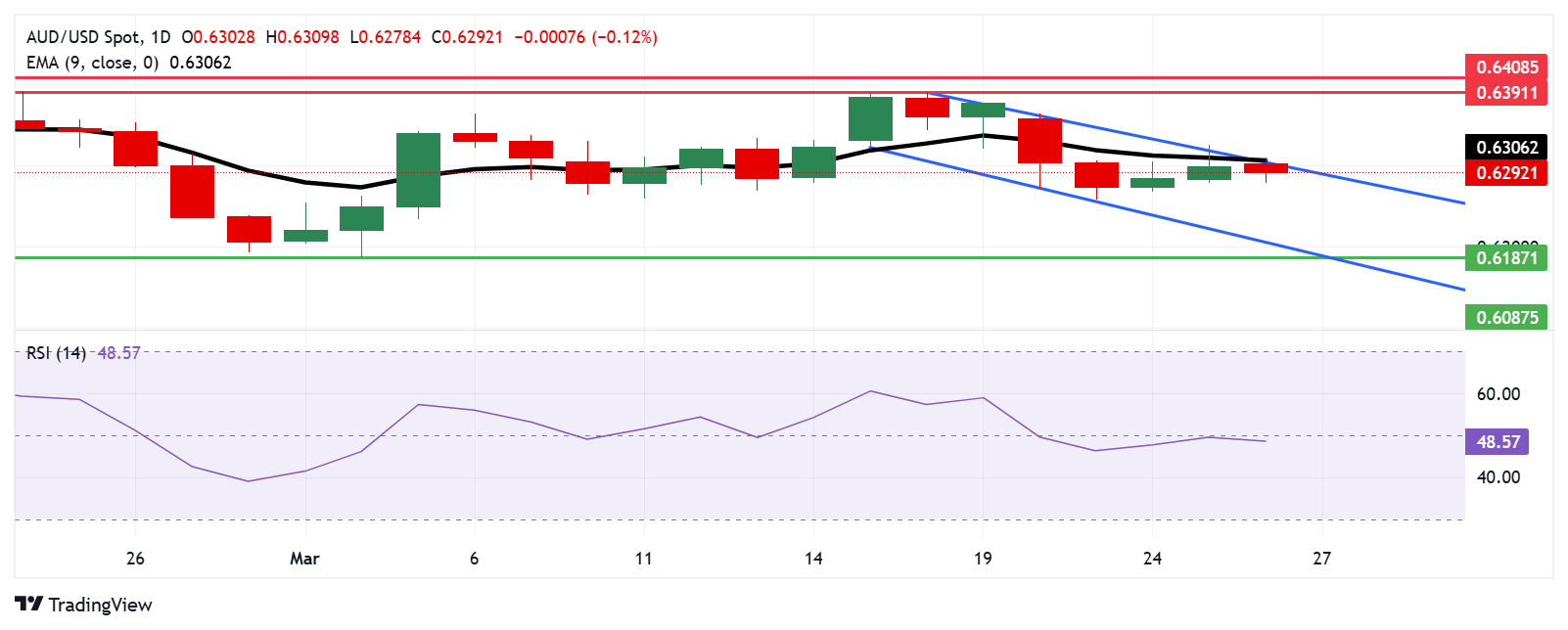- The Australian dollar weakened as the monthly consumer price index rose 2.4% year -on -year in February, compared to the expected increase of 2.5%.
- The Australian treasurer Jim Chalmers presented the 2025/26 budget on Tuesday, proposing tax cuts for a total of approximately 17.1 billion Australian dollars in two rounds.
- The US dollar is strengthened as the caution of the market grows before the announcement of tariffs of US President Donald Trump on April 2.
The Australian dollar (AUD) moves down against the US dollar (USD) after the publication of the monthly consumer price index (CPI) on Wednesday, which rose a 2.4% year -on -year in February, slightly below the increase of 2.5% of January and market expectations of 2.5%.
The Australian treasurer Jim Chalmers presented the 2025/26 budget on Tuesday, delineating key economic forecasts and tax cuts for a total of approximately 17.1 billion Australian dollars in two rounds. It is projected that the budget deficit is 27.6 billion Australian dollars by 2024-25 and 42.1 billion by 2025-26. GDP growth is expected to reach 2.25% in fiscal year 2026 and 2.5% in 2027. Fiscal cuts seem to be aimed at strengthening political support.
The Aud finds support as investors anticipate that the Bank of the Australian Reserve (RBA) will keep interest rates without changes next week, after its first cut of 25 basic points in four years last February. The subgovernor of the RBA (Economic) Sarah Hunter reaffirmed the cautious position of the Central Bank on future cuts, with the February policy statement pointing out a more conservative approach than market expectations, particularly in relation to US policy decisions and its impact on Australian inflation perspectives.
In addition, stimulus expectations in China could boost the Australian economy, given the strong commercial ties between both nations. The Communist Party of China and the State Council have proposed measures to “vigorously boost consumption” through the increase in wages and the reduction of financial charges, an effort to restore consumer confidence and revitalize the economy in difficulties.
The Australian dollar depreciates while the US dollar gains support in the middle of the caution of the market
- The American dollar index (DXY), which tracks the USD compared to six main currencies, recovers its recent losses from the previous session and is quoted around 104.30. The US dollar gains support as the caution of the market increases before the announcement of tariffs of US President Donald Trump on April 2. While Trump suggested that “many” countries could receive exemptions, the details of the tariff strategy of its administration remain uncertain.
- On Wednesday, Toronto Star cited Fuentes that indicate that Canada could face tariffs at the lower end in the next measures. However, nothing is guaranteed. Trump is considering three levels of staggered tariffs, although some sources suggest that this stepped approach is not officially on the table. However, it aligns with the government’s expectations about what could happen next week.
- The Global S&P reported Monday that the PMI composed of the US rose to 53.5 in March, from the minimum of 10 months of 51.6 in February, pointing out the strongest growth since December 2024. The PMI of services shot at 54.3 in March, a maximum of three months, from 51.0 in February. Meanwhile, the manufacturing PMI fell to 49.8 from 52.7, being below the 51.8 market expectations.
- The Governor of the Federal Reserve (Fed), Adriana Kugler, declared on Tuesday that the Central Bank’s interest policy remains restrictive and properly positioned. However, he acknowledged that progress towards the 2% inflation target has slowed since last summer and described the recent increase in assets inflation as “little useful.”
- The president of the Fed of Atlanta, Raphael Bostic, emphasized continuous uncertainty on Monday, stating that inflation progress may be slower than projected above. Bostic cut their expectations of feature cuts by 2025, citing persistent pressure on prices and trade -related risks.
- On Monday, the Judo Bank manufacturing PMI of Australia rose to 52.6 in March from 50.4 in February, while the PMI of Services improved to 51.2 from 50.8. The compound PMI also increased, reaching 51.3 in March compared to 50.6 above.
The Australian dollar goes back from the 0.6300 barrier near the nine -day EMA
The Aud/USD torque is quoted about 0.6280 on Wednesday, with technical indicators pointing out a bearish bias as the torque is consolidated within a descending channel. The 14 -day relative force (RSI) index remains slightly below 50, reinforcing the persistent bearish impulse.
In the lower part, the Aud/USD torque could navigate the region around the lower limit of the descending channel at 0.6210, followed by the minimum of seven weeks of 0.6187, registered on March 5.
The nine -day exponential (EMA) mobile average at 0.6306, aligned with the upper limit of the descending channel, acts as the immediate barrier. A breakout above this crucial resistance zone could weaken the bassist bias, with the parliamentary potentially testing the monthly maximum at 0.6391, reached on March 18.
AUD/USD: Daily graphic
Australian dollar Price today
The lower table shows the percentage of change of the Australian dollar (AUD) compared to the main currencies today. Australian dollar was the weakest currency against the US dollar.
| USD | EUR | GBP | JPY | CAD | Aud | NZD | CHF | |
|---|---|---|---|---|---|---|---|---|
| USD | 0.06% | 0.07% | 0.26% | 0.06% | 0.15% | 0.11% | 0.06% | |
| EUR | -0.06% | 0.00% | 0.16% | -0.00% | 0.10% | 0.04% | -0.01% | |
| GBP | -0.07% | -0.00% | 0.19% | -0.01% | 0.09% | 0.02% | 0.02% | |
| JPY | -0.26% | -0.16% | -0.19% | -0.18% | -0.12% | -0.15% | -0.17% | |
| CAD | -0.06% | 0.00% | 0.00% | 0.18% | 0.12% | 0.04% | 0.03% | |
| Aud | -0.15% | -0.10% | -0.09% | 0.12% | -0.12% | -0.05% | -0.08% | |
| NZD | -0.11% | -0.04% | -0.02% | 0.15% | -0.04% | 0.05% | -0.03% | |
| CHF | -0.06% | 0.00% | -0.02% | 0.17% | -0.03% | 0.08% | 0.03% |
The heat map shows the percentage changes of the main currencies. The base currency is selected from the left column, while the contribution currency is selected in the upper row. For example, if you choose the Australian dollar of the left column and move along the horizontal line to the US dollar, the percentage change shown in the box will represent the Aud (base)/USD (quotation).
Economic indicator
Consumer Price Index (MOM)
The consumer price index published by the Bank of the Australian Reserve (RBA) and reissued by the Australian Statistics Office It is a measure of the evolution of prices by comparing retail prices of a basket of representative purchase of goods and services. The purchasing power of the AU is dragged by inflation. The CPI is a key indicator to measure inflation and changes in purchase trends. A high reading is considered positive (or bullish) for the AUD, while a low reading is considered negative (or bassist).
Read more.
Last publication:
LIE MAR 26, 2025 00:30
Frequency:
Monthly
Current:
2.4%
Dear:
2.5%
Previous:
2.5%
Fountain:
Australian Bureau of Statistics
Source: Fx Street
I am Joshua Winder, a senior-level journalist and editor at World Stock Market. I specialize in covering news related to the stock market and economic trends. With more than 8 years of experience in this field, I have become an expert in financial reporting.








